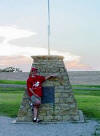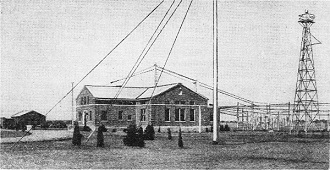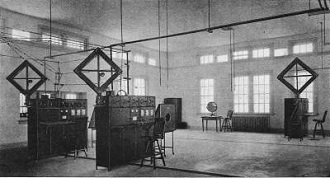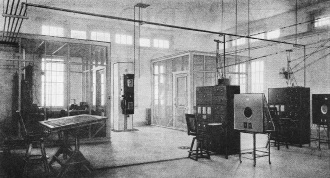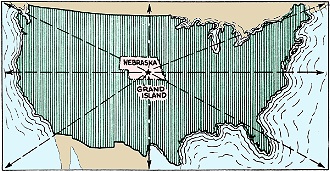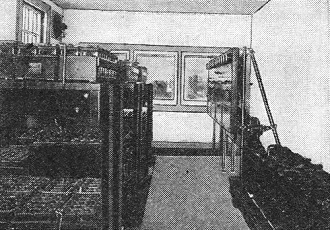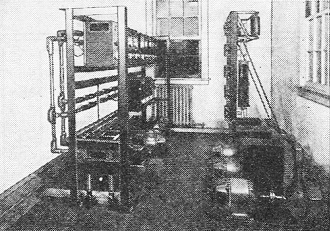Grand Island Monitor Station
|
|
The geographic center of the
48 contiguous (conterminous) states in America is located about 2.6 miles northwest
of the center of Lebanon, Kansas (39° 50' N, 98° 35' W). That is about 85 miles from the
FCC's (Federal Communication Commission) first central frequency monitoring station
at Grand Island, Nebraska. I have driven by that spot a couple times while traveling
on Interstate 80. Grand Island is probably not much bigger today than it was in
1932 when
Grand Island Monitor Station - Part I Fig. A - The main, building garage and engine room, plane beacon, and antenna system at the U. S. Monitor Station, Grand Island, Nebraska. Since the advent of Radio, there has been an increasing need for some system of accurately checking the frequency of transmitted radio waves. Before the general use of crystal-controlled transmitters, calibrated wave-meters served their purpose very well. However, in order to have any regulation of radio transmitters it is absolutely essential that the methods of measuring used by the regulating agency be far more accurate than any method used by the stations involved. The discovery of the great value of high frequencies in radio made the problem of frequency measuring an international, as well as a national one. Several years ago, Mr. S. W. Edwards, then Supervisor of Radio at Detroit, Michigan, foresaw the value of a centrally located monitoring station, supplemented by several strategically located secondary standards, and bent his efforts toward securing such a system for the Radio Division of the Department of Commerce. The appropriation of approximately $400,000 for land and buildings having been secured, the next problem was to draw up a primary standard and associated equipment, and eight secondary standards and their associated units. It was then found that few companies were able to build measuring equipment of the required accuracy and receivers of the necessary sensitivity and selectivity. The award was finally made to the Westinghouse Electric & Manufacturing Company and a great deal of the equipment now used has been manufactured by them. Location of Station Fig. B - One-half of the main instrument room of Uncle Sam's "air police." Every point of the compass is under inspection, at will. With the manufacture of equipment well under way, the next move was to secure a location for the central frequency monitoring station. An extensive field strength survey was made of the middle-west, and finally Nebraska was chosen as the most likely state in which to locate the station. Several factors prompted the choosing of Grand Island as a location. Chief among these was, first, it is centrally located in the United States; second, the level nature of the terrain makes for receiving conditions approaching the ideal; and third, the action of the Grand Island Chamber of Commerce in selling the government fifty acres of land for one dollar. The exact location of the station is six miles west of Grand Island. It was deemed necessary that the station should be several miles from any center of population, in order to get away from "man-made static." Considerable care was necessary in planning the station itself. As it is an isolated plant, it must be equipped with a good water supply, power supply, and heating and sewage-disposal systems. In order to satisfactorily accomplish the work required of the station, it was also necessary to build an extensive antenna system. A visitor cannot help but be somewhat impressed by the amount of detail that has gone into the construction of this Frequency Monitoring Station, and can readily see that to properly man all of this highly scientific equipment calls for a personnel of great ability who are well trained in their particular phase of the work. At present, there are 27 people employed at the station. In addition to the Manager (Mr. Benjamin Wolf) and Assistant Manager there are eight engineers, all of whom hold B.S. degrees in electrical engineering or have had wide radio experience, eight radio operators loaned the Radio Division by the Airways Division of the Department of Commerce, four Diesel engineers, one chief clerk, two stenographers and two janitors. This is enough to operate the station 16 hours a day. It is hoped that funds will be available Inter to add enough personnel to operate 24 hours a day. Fig. C - The other half of the main instrument room of the U.S. Government's broadcast station frequency monitor system at Grand Island. It was mentioned in the first part of this article that in planning the station, the design engineer was confronted with the usual problems of an isolated plant, many of which were outside the radio field. Among these were the buildings, heating and sewage-disposal systems, and primary power supply. In this work, the help of the Bureau of Yards and Docks of the Navy Department was sought and obtained. The architect was F. W. Southworth of the Navy Department. Buildings and Power Supply There are two buildings, a main building shown in Fig. A, and a combination engine room and garage. The main building houses the radio equipment and heating plant. It is built of red brick and in the shape of a cross. The main floor has a motor-generator room, a battery room, workshop, main instrument room which is 72 x 35 feet, an office and a kitchen. The second floor has a dormitory and small office and the basement has a storeroom and boiler room. The kitchen and dormitory are for emergency purposes in case the personnel are storm bound. The other building is built also of red brick and is divided into a four-car garage, a work shop, and engine room. The primary power supply is two 40-H.P. Diesel engines driving 240-volt, 60-cycle 3-phase alternators. Diesel engines were used in order to eliminate ignition interference. The engines are Fairbanks-Morse 3-cylinder, 2-cycle Marine type. Two 2000-gallon fuel oil tanks, buried outside the engine room, furnish fuel oil for both the Diesel engines and the oil burning furnace in the main building. The power from the alternators is made available in the main building through underground lines to a distributing panel in the motor-generator room. Motor-generator sets and rectifier units provide the necessary D.C. for battery charging. The standards and receivers, shown in Figs. B and C, are all operated from battery supply. Fig. 1 - Grand Island, Nebraska, the most desirable spot in the United States for the reception of all our broadcast station programs. General view of the battery room of the U. S. Monitor Station at Grand Island, Nebraska. The room is well ventilated in order to allow the fumes that are generated, to escape. Distributing panel in one of the generator rooms at Grand Island. The generators used for charging the batteries are shown to the right of the picture. In the engine room beside the engines and their associated equipment, is a motor-driven pump which is capable of delivering 125 gallons of water per minute. The capacity of the well itself is in excess of 500 gallons a minute. This well is used to furnish the general water supply as well as an irrigation supply for seven acres of ground surrounding the buildings. This acreage has been landscaped and in a few years should be one of the beauty spots of Nebraska. The Stars and Stripes floating from a seventy-foot flag pole in front of the main building advertises the fact that this is a Federal institution. The numerous fifty-foot poles and the antenna network supported by them have been recognized as a definite hazard to aircraft. For this reason, a sixty-foot tower with a 2-million candle power revolving red beacon mounted on top, has been erected on the grounds. A white course-light pointing directly to the local airport is mounted just below the red beacon. Every effort has been made in constructing the station to eliminate inductive interference. All motors used at the station are of the induction type. All power leads are shielded. Copper mesh is incorporated within the walls, ceiling and floor of the motor-generator room. All outside power leads are underground. The telephone cable enters the station through nearly 3/4-mile of underground duct. This is a 26-wire cable and furnishes ample facilities for local and long-distance telephone communication. The Sequence of Measuring Station Frequencies Each measurement goes through four operations before it is turned in to the office. First, the station must be intercepted and identified by the receiving operator; second, the measuring sheet goes to the measuring booth where the station is measured and the sheet stamped in order of its submittal; third, the final results must be calculated; and fourth, the entire sheet is checked.All the sheets from one day's watch are turned in to the office the following morning and made up into a report sheet, which is sent in to the Radio Division at Washington. Already the needs of the plant have outgrown its present size. Many more directional antennas are needed if the station is to give the same service to all parts of the country. This necessarily means more land, more receiving equipment and more personnel. A high power short-wave transmitter is needed for more rapid reporting of frequency deviations. The station must grow and change as the radio art grows and changes. With proper support, the future of the station is bright. Uses of the Station The station is designed primarily for the purpose of checking the transmitting frequencies of all the broadcast stations in the United States, as well as a considerable number of foreign broadcasters. Aside from its routine task, Grand Island performs numerous other special services for the Government. It is prepared, for example, to report on radio transmission in practically any country on the globe. Station wavelengths are measured against the Standard Precision Clock which is mounted in a vacuum chamber in a ten-ton concrete column. The Precision Clock corresponds to the standard pound, tile standard foot, the standard quart, etc., in Washington, and is law to the broadcasters. Its pendulum makes one complete swing in two seconds, or covers one-half cycle in one second. This frequency is multiplied through a tuning fork and vacuum tube amplifiers to 30,000 cycles per second, from which harmonics are produced and selected to match the lowest or highest radio frequencies in commercial use. While reception is taking place careful notes are made of weather conditions, barometrical pressure, and other items which tend to furnish information on transmitting conditions. Approximate signal strengths are noted as well as any other characteristics of the received signal. By reason of this information, it is expected that transmitting conditions under given circumstances will be predictable, and that it will be known, in a general way, what stations can be re-received under certain conditions and at what times reception will be at its best. In the second part of this article, which will appear in the March issue of Radio-Craft, the antenna system and all other available information concerning this interesting station will be given.
Posted February 27, 2023 |
|

